八年级(下)Module3Unit3教案
- 格式:doc
- 大小:72.00 KB
- 文档页数:5
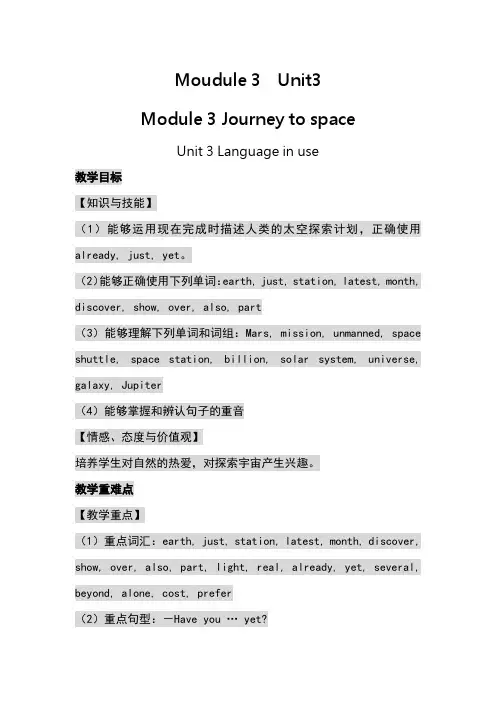
Moudule 3 Unit3Module 3 Journey to spaceUnit 3 Language in use教学目标【知识与技能】(1)能够运用现在完成时描述人类的太空探索计划,正确使用already, just, yet。
(2)能够正确使用下列单词:earth, just, station, latest, month, discover, show, over, also, part(3)能够理解下列单词和词组:Mars, mission, unmanned, space shuttle, space station, billion, solar system, universe, galaxy, Jupiter(4)能够掌握和辨认句子的重音【情感、态度与价值观】培养学生对自然的热爱,对探索宇宙产生兴趣。
教学重难点【教学重点】(1)重点词汇:earth, just, station, latest, month, discover, show, over, also, part, light, real, already, yet, several, beyond, alone, cost, prefer(2)重点句型:-Have you … yet?-Yes, I / we have already / just …-No, not yet. / No, I / we haven’t … yet.-I have been to … He/ She has gone to …(3)话题:宇宙探索【教学难点】(1)用现在完成时描述人类已经实施的太空探索计划。
(2)have been to与have gone to的区别。
教学准备A tape recorder, multimedia and some pictures教学过程1. Leading-inTask 1: RevisionShow some pictures and ask students to discuss in pairs and make sentences like these:(1) Scientists have sent spaceship to Mars.The journey has taken several months.(2) Astronauts have already been to the moon.Look at the pictures, discuss in pairs and make sentences like these:(1) Scientists have sent spaceship to Mars.The journey has taken several months.(2) Astronauts have already been to the moon.2. While-taskTask2: Consolidation and extension1. Explain the grammar to the students: 现在完成时( have / has +done), especially the uses of have been to and have gone to.2. Let the students do Activity 4, then check the answers.3. Ask the students to work in pairs. Role-play the conversation in Activity4.4. To consolidate the uses of have been to & have gone to Ask the students to do Activity 2 and Activity3 individually, and then check the answers.5. Let the students do Activity 8: Complete the word map with the words and expressions in the box. Then check the answers from the whole class.6. Do a listening.Ask the students to listen and complete the notes, and then check the answers. (Activity 7)7. Let the students do Activity9, then check the answers.8. Ask students to read “Around the world”, and then answer the questions after reading.Q1:What do European languages use for the days of the week?Q2: What day is named after the planet Saturn?Q3: Is Monday the day of the moon?6. Check the answers.3. Post-taskTask 3: Making a poster1. Ask students to work in groups of six: Making a poster about space travel.2. Help the students choose a subject, for example, the first moon landing or China’s manned space travels. And look for some photos and information about it.3. Guide the students to write captions for the photos and use the information they found to write a description of each one and give the poster a title. Let them put their posters up for their classmates to see after finishing.4. Choose the best poster.Task4: ExerciseLet students do some exercises and then check.4. SummaryAsk the students to say out what to learn.课堂作业Finish the workbook of Unit 3.教学反思。
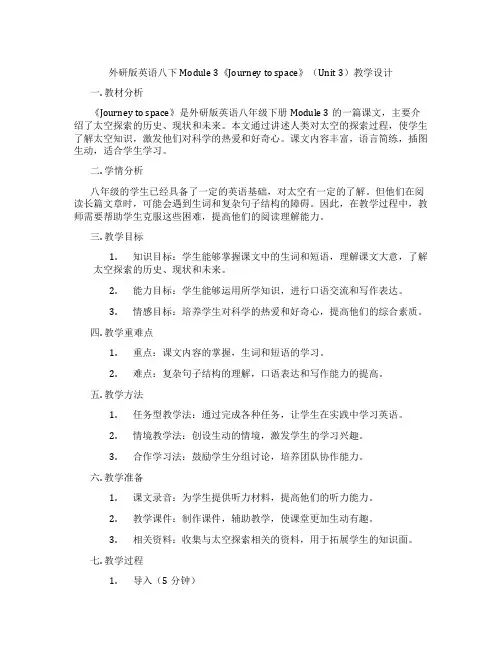
外研版英语八下Module 3《Journey to space》(Unit 3)教学设计一. 教材分析《Journey to space》是外研版英语八年级下册Module 3的一篇课文,主要介绍了太空探索的历史、现状和未来。
本文通过讲述人类对太空的探索过程,使学生了解太空知识,激发他们对科学的热爱和好奇心。
课文内容丰富,语言简练,插图生动,适合学生学习。
二. 学情分析八年级的学生已经具备了一定的英语基础,对太空有一定的了解。
但他们在阅读长篇文章时,可能会遇到生词和复杂句子结构的障碍。
因此,在教学过程中,教师需要帮助学生克服这些困难,提高他们的阅读理解能力。
三. 教学目标1.知识目标:学生能够掌握课文中的生词和短语,理解课文大意,了解太空探索的历史、现状和未来。
2.能力目标:学生能够运用所学知识,进行口语交流和写作表达。
3.情感目标:培养学生对科学的热爱和好奇心,提高他们的综合素质。
四. 教学重难点1.重点:课文内容的掌握,生词和短语的学习。
2.难点:复杂句子结构的理解,口语表达和写作能力的提高。
五. 教学方法1.任务型教学法:通过完成各种任务,让学生在实践中学习英语。
2.情境教学法:创设生动的情境,激发学生的学习兴趣。
3.合作学习法:鼓励学生分组讨论,培养团队协作能力。
六. 教学准备1.课文录音:为学生提供听力材料,提高他们的听力能力。
2.教学课件:制作课件,辅助教学,使课堂更加生动有趣。
3.相关资料:收集与太空探索相关的资料,用于拓展学生的知识面。
七. 教学过程1.导入(5分钟)教师播放太空探索的短视频,引导学生谈论对太空的了解和兴趣,为新课的学习营造氛围。
2.呈现(10分钟)教师展示课文图片,引导学生观察并猜测课文内容。
然后逐段呈现课文,让学生跟读并模仿语音语调。
3.操练(10分钟)教师设计各种任务,如填空、选择、问答等,让学生分组完成,巩固课文内容。
4.巩固(5分钟)教师学生进行角色扮演,模拟太空探索的场景,提高他们的口语表达能力。
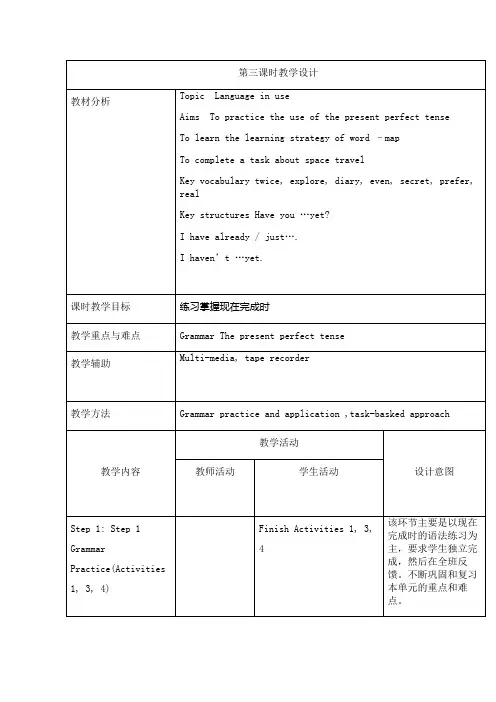
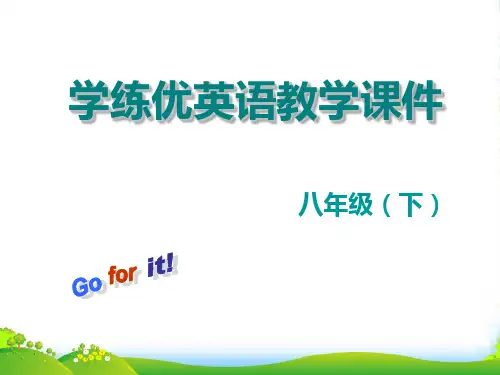
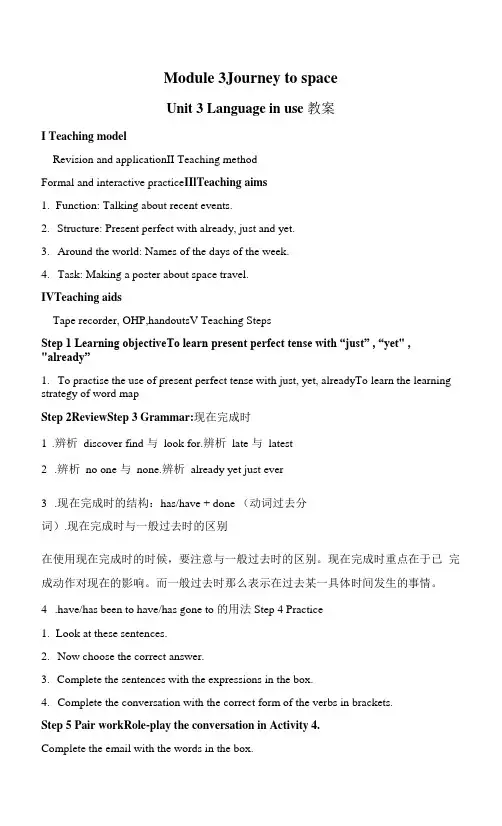
Module 3Journey to spaceUnit 3 Language in use 教案I Teaching modelRevision and applicationII Teaching methodFormal and interactive practice IIlTeaching aims1.Function: Talking about recent events.2.Structure: Present perfect with already, just and yet.3.Around the world: Names of the days of the week.4.Task: Making a poster about space travel.IVTeaching aidsTape recorder, OHP,handoutsV Teaching StepsStep 1 Learning objectiveTo learn present perfect tense with “just” , “yet" , "already”1.To practise the use of present perfect tense with just, yet, alreadyTo learn the learning strategy of word mapStep 2ReviewStep 3 Grammar:现在完成时1.辨析discover find 与look for.辨析late 与latest2.辨析no one 与none.辨析already yet just ever3.现在完成时的结构:has/have + done (动词过去分词).现在完成时与一般过去时的区别在使用现在完成时的时候,要注意与一般过去时的区别。
现在完成时重点在于已完成动作对现在的影响。
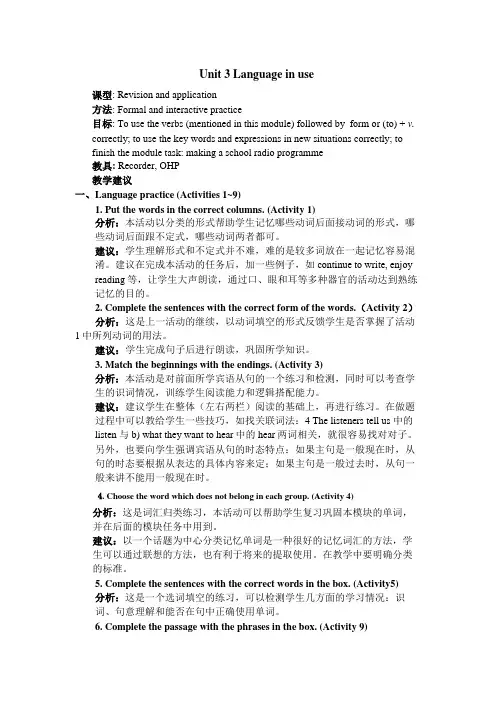
Unit 3 Language in use课型: Revision and application方法: Formal and interactive practice目标: To use the verbs (mentioned in this module) followed by form or (to) + v.correctly; to use the key words and expressions in new situations correctly; to finish the module task: making a school radio programme教具: Recorder, OHP教学建议一、Language practice (Activities 1~9)1. Put the words in the correct columns. (Activity 1)分析:本活动以分类的形式帮助学生记忆哪些动词后面接动词的形式,哪些动词后面跟不定式,哪些动词两者都可。
建议:学生理解形式和不定式并不难,难的是较多词放在一起记忆容易混淆。
建议在完成本活动的任务后,加一些例子,如 continue to write, enjoy reading 等,让学生大声朗读,通过口、眼和耳等多种器官的活动达到熟练记忆的目的。
2. Complete the sentences with the correct form of the words.(Activity 2)分析:这是上一活动的继续,以动词填空的形式反馈学生是否掌握了活动1中所列动词的用法。
建议:学生完成句子后进行朗读,巩固所学知识。
3. Match the beginnings with the endings.(Activity 3)分析:本活动是对前面所学宾语从句的一个练习和检测,同时可以考查学生的识词情况,训练学生阅读能力和逻辑搭配能力。
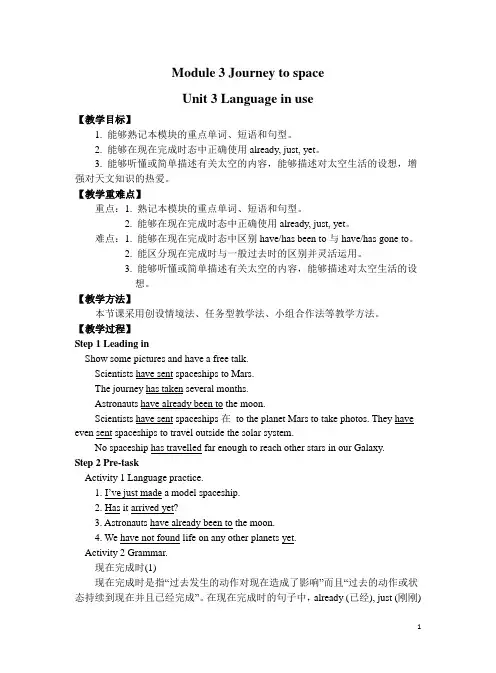
Module 3 Journey to spaceUnit 3 Language in use【教学目标】1. 能够熟记本模块的重点单词、短语和句型。
2. 能够在现在完成时态中正确使用already, just, yet。
3. 能够听懂或简单描述有关太空的内容,能够描述对太空生活的设想,增强对天文知识的热爱。
【教学重难点】重点:1. 熟记本模块的重点单词、短语和句型。
2. 能够在现在完成时态中正确使用already, just, yet。
难点:1. 能够在现在完成时态中区别have/has been to与have/has gone to。
2. 能区分现在完成时与一般过去时的区别并灵活运用。
3. 能够听懂或简单描述有关太空的内容,能够描述对太空生活的设想。
【教学方法】本节课采用创设情境法、任务型教学法、小组合作法等教学方法。
【教学过程】Step 1 Leading inShow some pictures and have a free talk.Scientists have sent spaceships to Mars.The journey has taken several months.Astronauts have already been to the moon.Scientists have sent spaceships在to the planet Mars to take photos. They have even sent spaceships to travel outside the solar system.No spaceship has travelled far enough to reach other stars in our Galaxy.Step 2 Pre-taskActivity 1Language practice.1. I’ve just made a model spaceship.2. Has it arrived yet?3. Astronauts have already been to the moon.4. We have not found life on any other planets yet.Activity 2 Grammar.现在完成时(1)现在完成时是指“过去发生的动作对现在造成了影响”而且“过去的动作或状态持续到现在并且已经完成”。
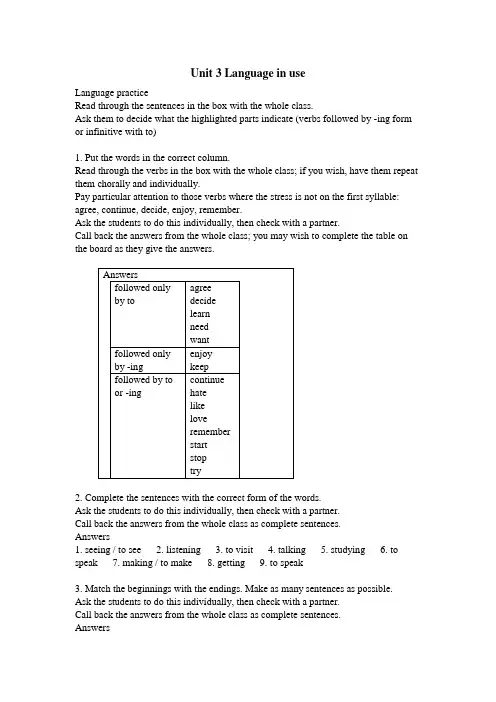
Unit 3 Language in useLanguage practiceRead through the sentences in the box with the whole class.Ask them to decide what the highlighted parts indicate (verbs followed by -ing form or infinitive with to)1. Put the words in the correct column.Read through the verbs in the box with the whole class; if you wish, have them repeat them chorally and individually.Pay particular attention to those verbs where the stress is not on the first syllable: agree, continue, decide, enjoy, remember.Ask the students to do this individually, then check with a partner.Call back the answers from the whole class; you may wish to complete the table on the board as they give the answers.2. Complete the sentences with the correct form of the words.Ask the students to do this individually, then check with a partner.Call back the answers from the whole class as complete sentences.Answers1. seeing / to see2. listening3. to visit4. talking5. studying6. to speak7. making / to make8. getting9. to speak3. Match the beginnings with the endings. Make as many sentences as possible.Ask the students to do this individually, then check with a partner.Call back the answers from the whole class as complete sentences.Answers1. Everybody knows when she came into this room. / what they want to hear. / how long the Great Wall is. / that they won the first prize last week. / why they must be quiet. / who the most popular singer is.2. We will find out when she came into this room. / what they want to hear. / how long the Great Wall is. / why they must be quiet. / who the most popular singer is.3. Please tell me when she came into this room. / what they want to hear. / how long the Great Wall is. / that they won the first prize last week. / why they must be quiet. / who the most popular singer is.4. The listeners tell us what they want to hear. / who the most popular singer is.5. They were happy to know that they won the first prize last week.6. He asked when she came into this room.7. Did they know that he was doing at that time?8. Have you heard that he will come?4. Choose the word which does not belong in each group.Ask the students to complete this individually, then check with a partner.Call back the answers, having one student read out the list of words and another say which is the odd one out.Answers1. reporter (a person, all the others are parts of a newspaper)2. glass (a kind of material, all the others are about the weather)3. studio (all the others are about a competition)4. manager (all the others are about a newspaper)5. sunny (all the others are about columns of a newspaper)5. Complete the sentences with the correct form of the words in the box.Ask the students to do this individually, then check with a partner.Call back the answers from the whole class as complete sentences.Answers1. weather report; weather2. sunny; rain3. prepare4. latest; result5. scored; won6. sports6. Ask and answer the questions.Ask the students to do in pairs.Call back the answers from the whole class, having one student ask a question and another answer it.7. Listen and say what Kate’s job is.Read the three jobs out to the whole class.Ask them to listen to the recording once and decide which is Emma’s job.Call back the answer from the whole class.Answerb8. Listen again and choose the best answer.Ask the students to read through the questions to themselves.Play the recording once while they listen and focus.Play it again for them to answer. They can then check with a partner.Play it once more for them to complete, check and correct.Call back the answers from the whole class, having one student ask a question and another answer.Answers1. a2. c3. c4. b5. a, b, c, e9. Complete the passage with the phrases in the box.Read through the phrases in the box with the whole class, having them repeat them chorally and individually.Ask the students to do the exercise individually, then check with a partner.Call back the answers from the whole class as complete sentences.Answers1. take you around2. look out for3. would like to4. look out of5. closes down6. the end ofAround the worldRead through the box with the whole class.Ask them some questions about the information, . Why is it important the radio works on clockwork? (Because it requires no batteries or electricity)Culture box: BBC RadioThe British Broadcasting Corporation (BBC) has five national radio stations. Radio 1 plays only pop music all day and night. Radio 2 plays a mixture of light music and general interest programs. Radio 3 is the classical music program. Radio 4 is the serious channel, with a mixture of in-depth news coverage, interviews with important people and special focus documentaries. Radio 5 has sport.The BBC also has a network of local radio stations around Britain which offer a mixture of music and more local news and interest items.The BBC World Service broadcasts news and entertainment programs in English and other languages around the world.Module task: Making a school radio programActivities 10~12Read through the instructions with the whole class.Ask them to get into groups of six .Give them time to plan their program in class, and decide who is writing what (you should encourage them each to write one part of the program).Then ask them to do the writing at home.Back in class they can put the program together.If you or they have the facilities to record it, then do so. Otherwise, they can present it ‘live’ to the rest of the class.。

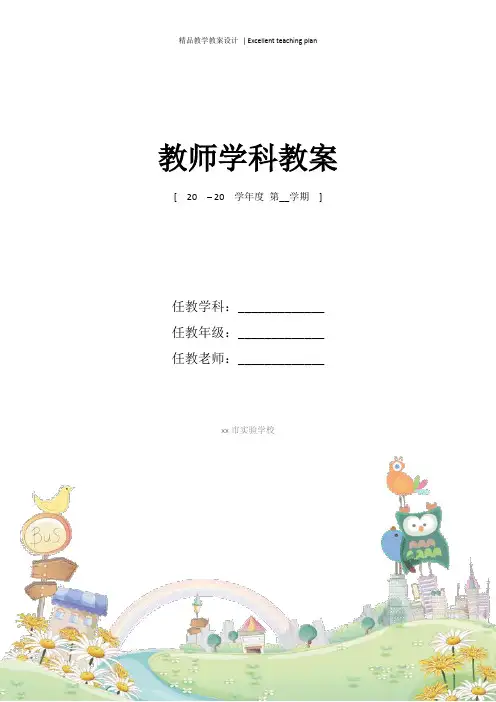
教师学科教案[ 20 – 20 学年度第__学期]任教学科:_____________任教年级:_____________任教老师:_____________xx市实验学校The 4th period Date: Sep.Module 3 . Unit 3 Language in useTeaching Content: Language in useKey structures: Have you… yet?I have already…I haven’t … yet.Teaching Aims and Demands:1. To summarize and consolidate the use of present perfect tense.2. To summarize and consolidate expressions and vocabulary.3.Affection and attitudes: We should love science and our country.Learning strategies: Formal instruction and task-based approach and interactive practice.Teaching Aids: Multi-Media (video, OHP, handout)Importance and difficulty: The use of prestent perfectTeaching Procedures:Part I RevisionHelp students to revise what is learnt in 3 periods of this module.Part II Language practiceTask1: To summarize and consolidate the usage of present perfect tense.(1).Run through the examples with the Ss. and make sure that they are familiar with the use of present perfect tense.(2). Ask the Ss. to repeat the sentences in the box.(3). Ask“Can you make other similar examples?”(4).Focus the Ss’s attention on the ways in which they are used:Task2: To summarize and consolidate the use of present perfect tense.(1). Do activities 1and 2 on page 22.(2). Ask the Ss. to call out the answers from the whole class.(3). Ask the Ss. to read the complete sentences.(4). Then do activities 3 and 4 and 5 on page 23. Then role-play the conversation in Activity 5.(5) Summarize: the formation of the present perfect tense.Task 3: Complete the passage with the words in the box in Activity 7.(1)Ask the Ss. to complete the passage with the words in the box.(2)Exchange work and peer correct with another pair for accuracy.(3)Call the answers back from the class.Task 4: Listen to this interview and choose the correct answers in Activity 7.(1)Ask the Ss. to listen to the interview and choose the correct answers(2)Exchange work and peer correct with their deskmate for accuracy.(3)Call the answers back from the class as complete sentences.Task 5: Add the words and expressions to the word map in Activity 9.Directions:(1)Ask the Ss. to look at the word map and add the words and expressions to it.(2)Exchange work and peer correct with their deskmates for accuracy.(3)Call the answers back from the class.Part IV: A testDo Ex 2 on page 120 i n the WB. Let’s see who can finish it as soon as possible. Homework:Finish all the exercises in the WB.Blackboard Activities:Postscript:。
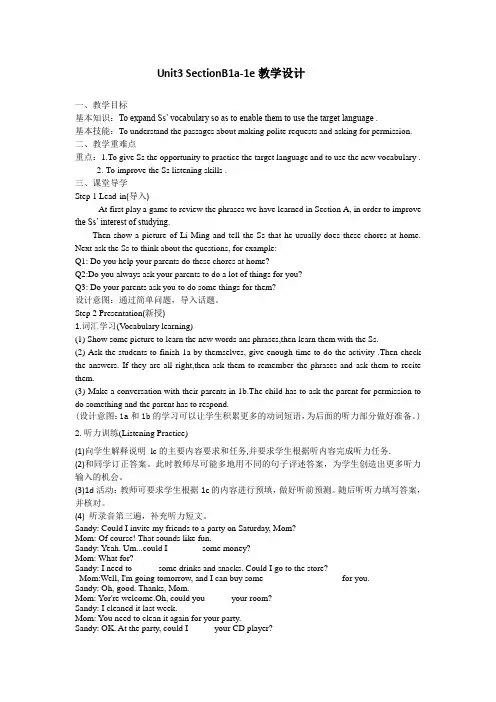
Unit3 SectionB1a-1e教学设计一、教学目标基本知识:To expand Ss’ vocabulary so as to enable them to use the target language .基本技能:To understand the passages about making polite requests and asking for permission. 二、教学重难点重点:1.To give Ss the opportunity to practice the target language and to use the new vocabulary .2.To improve the Ss listening skills .三、课堂导学Step 1 Lead-in(导入)At first play a game to review the phrases we have learned in Section A, in order to improve the Ss’ interest of studying.Then show a picture of Li Ming and tell the Ss that he usually does these chores at home. Next ask the Ss to think about the questions, for example:Q1: Do you help your parents do these chores at home?Q2:Do you always ask your parents to do a lot of things for you?Q3: Do your parents ask you to do some things for them?设计意图:通过简单问题,导入话题。
Unit3 Could you please clean your room?Section B 2a – 2c教案学习目标1.知识目标(1)能掌握以下单词和短语:chore; stress; waste; in order to; provide; anyway; depend; develop; fairness; fair; since; neighbor; ill; drop; independence; independent等。
(2)能熟练掌握并使用下列句式,谈论自己的观点:They don’t have time to study and do housework.It is the parents’ job to provide a clean and comfortable environment at home for their children.It’s not enough to just get good grades at school.…that everyone should do their part in keeping it clean and tidy.The earlier kids learn to be independent, the better it is for their future.2.能力目标通过阅读训练,培养学生的良好的阅读理解能力,同时使学生通过阅读中心句的方式把握文章大意的技巧略读,对议论文中的观点进行进一步的解读,以实现对学生对家务劳动的深刻理解;并学会用英语表达自己的想法。
3. 情感目标通过本课的学习,不能过多依赖父母,要在学习之余,培养独立性,帮助父母做家务劳动是很重要的。
教学重难点1.在理解两封信的基础上对文章进行进一步的解读。
2.对于3a中两封持不同观点的信的结构掌握和关键信息提取,理解作者要表达的观点和理由并且学会用英语表达自己的看法。
Module 3 Journey to space
主备人:沙慧琴彭瑞珍审核人:___________ 复备人:____________
一、教学内容:Unit3 Language in use
二、课型:Revision and application
三、教学目标:
1. 正确运用本模块的词汇及短语
2、掌握现在完成时中的already、just和yet的用法,并能正确运用have been to 和
have gone to。
3. 引导学生制作一张关于太空旅行的海报,让学生了解更多的航天知识。
四、教学重难点:
掌握现在完成时中的already、just和yet的用法,并能正确运用have been to 和have gone to。
五、教学准备:
本节课型为Revision and application,根据新课标的要求,结合教材和学生特点,主要采用任务型互动式进行教学,结合情景法、交际法、听说法、归纳法等教学方法实施课堂活动,开启学生思维,通过一系列有条理的教学活动,引导学生自主探究学习和与他人互动合作学习,让学生体验愉快学习。
本节课所需教具及资料:幻灯、图片、调查表等。
六、教学过程:
达标训练题
一、用括号内所给动词的适当形式完成句子。
1. —Where’s Uncle Black? I can’t find him.
— He _____ ______ (go) to Sichuan to help people in a disaster area (灾区).
2. — _____ you ever _____ (eat ) Beijing roast duck?
—Yes. It’s delicious.
3. — I have _____ ____ (not see) Water Margin (《水浒》) .
— Really? I _______(see) it yesterday.
4. — How long _____ you _______ (work) in the factory?
— For five weeks till now.
5. Shenzhen ____ (be) a small town fifty years ago. Now it _______ _______(become) a large city.
二、阅读理解
Life on the earth depends on the sun. Day after day we see its light and feel its warmth. The sun is ninety—three million miles away from the earth .
The sun is a large star. The earth is very small among its planets. Every day the sun sends out a great deal of heat and makes us feel hot. But we receive only a small part of the heat, because the sun is so far way from us and its light loses more of its energy(能量).When it reaches the growth of trees, plants and humans. On the other hand ,much heat and light would do harm(危害)to us. The heat and light from the sun come in just the right quantities(数量)for life on the earth.
( ) 1. The earth is a ________.
A. star
B. satellite
C. planet
D. moon
( ) 2. The earth receives _______of the s un’s heat and light.
A. all
B. less
C. not enough
D. right quantities
( ) 3. The temperature of the sun is _______ that of the earth.
A. very higher than
B. much higher than
C. the same as
D. more higher than
( ) 4. It is _____ from the sun to the earth.
A. quite far
B. very near
C. a lot of farther
D. more higher than ( ) 5. The heat and light from the sun is __________for life on the earth.
A. more
B. less C .bad D. fit
Keys: 一、1. has gone 2. Have, eaten 3. never seen, saw
4.have, worked
5. was, has become
二、1-5 CBBAD。